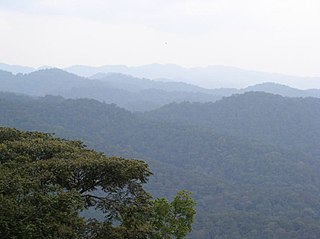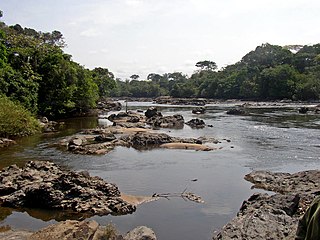
Gorillas are herbivorous, predominantly ground-dwelling great apes that inhabit the tropical forests of equatorial Africa. The genus Gorilla is divided into two species: the eastern gorilla and the western gorilla, and either four or five subspecies. The DNA of gorillas is highly similar to that of humans, from 95 to 99% depending on what is included, and they are the next closest living relatives to humans after chimpanzees and bonobos.

Coltan is a dull black metallic ore from which the elements niobium and tantalum are extracted. The niobium-dominant mineral in coltan is columbite, and the tantalum-dominant mineral is tantalite.

The mountain gorilla is one of the two subspecies of the eastern gorilla. It is listed as endangered by the IUCN as of 2018.

The western lowland gorilla is one of two Critically Endangered subspecies of the western gorilla that lives in montane, primary and secondary forest and lowland swampland in central Africa in Angola, Cameroon, Central African Republic, Republic of the Congo, Democratic Republic of the Congo, Equatorial Guinea and Gabon. It is the nominate subspecies of the western gorilla, and the smallest of the four gorilla subspecies.

The western gorilla is a great ape found in Africa, one of two species of the hominid genus Gorilla. Large and robust with males weighing around 168 kilograms (370 lb), the species is found in a region of midwest Africa, geographically isolated from the eastern gorilla. The hair of the western species is significantly lighter in color.

The eastern gorilla is a critically endangered species of the genus Gorilla and the largest living primate. At present, the species is subdivided into two subspecies. There are 6,800 eastern lowland gorillas or Grauer's gorillas and 1,000 mountain gorillas. Illegal hunting threatens the species.

The Albertine Rift montane forests is a tropical moist broadleaf forest ecoregion in east-central Africa. The ecoregion covers the mountains of the northern Albertine Rift, and is home to distinct Afromontane forests with high biodiversity.

The wildlife of the Democratic Republic of the Congo includes its flora and fauna, comprising a large biodiversity in rainforests, seasonally flooded forests and grasslands.
Grauer's swamp warbler is a species of Old World warbler in the family Locustellidae. It is found in Burundi, Democratic Republic of the Congo, Rwanda, and Uganda. Its natural habitats are freshwater lakes and freshwater marshes. It is threatened by habitat loss.
Grauer's cuckooshrike is a little known species of bird in the family Campephagidae. It is endemic to the Democratic Republic of the Congo. It is found in mid-elevation montane forests, where it can be locally common. Similar to other species endemic to the eastern Democratic Republic of the Congo, it is rarely reported due to ongoing armed conflict in the Albertine Rift.
Kerry Bowman is a Canadian bioethicist and environmentalist based in Toronto, Ontario.

The central chimpanzee or the tschego is a subspecies of chimpanzee. It can be found in Central Africa, mostly in Gabon, Cameroon, Republic of Congo and the Democratic Republic of Congo.

The Institut Congolais pour la Conservation de la Nature is a Congolese governmental partner tasked with the protection and conservation of the Virunga National Park and Kahuzi-Biega National Park, both UNESCO World Heritage Sites in the Democratic Republic of Congo. Members of the ICCN are charged with the overall protection of the parks and the endangered mountain gorilla. The ICCN works with various national and international NGO partners.
iGorilla is a software application (app) that is designed for use with the internet and multimedia enabled smartphones iPhone or iPod Touch, which were created by Apple Inc. iGorilla is the first app to be dedicated to the protection of mountain gorillas and is evidence that organizations involved in wildlife conservation are using digital media technology to raise funds and awareness by communicating directly with people who are concerned about the planet’s biological heritage.
Mount Kahuzi is an extinct volcano in the Democratic Republic of the Congo. It is within the Kahuzi-Biéga National Park, a World Heritage Site.

The Kahuzi-Biega National Park is a protected area near Bukavu town in eastern Democratic Republic of the Congo. It is situated near the western bank of Lake Kivu and the Rwandan border. Established in 1970 by the Belgian photographer and conservationist Adrien Deschryver, the park is named after two dormant volcanoes, Mount Kahuzi and Mount Biega, which are within its limits. With an area of 6,000 square kilometres (2,300 sq mi), Kahuzi-Biega is one of the biggest national parks in the country. Set in both mountainous and lowland terrain, it is one of the last refuges of the rare species of Eastern lowland gorilla, an endangered category under the IUCN Red List. The park is a UNESCO World Heritage Site, inscribed in 1980 for its unique biodiversity of rainforest habitat and its eastern lowland gorillas. In 1997, it was listed on the List of World Heritage in Danger because of the political instability of the region, an influx of refugees, and increasing wildlife exploitation.

Rudolf Grauer was an Austrian explorer and zoologist.

The Northeastern Congolian lowland forests is a tropical moist broadleaf forest ecoregion that spans the Democratic Republic of the Congo and the Central African Republic.
Environmental issues in the Democratic Republic of the Congo are the consequence of compounding social and economic problems, including lack of access to clean energy, clearing of lands for agriculture and economic development, and armed conflict. Major environmental issues in DRC include deforestation, poaching, which threatens wildlife populations, water pollution and mining.
Adrien Deschryver was a Belgian photographer and conservationist, who established and was chief warden of the Kahuzi-Biega National Park near the western bank of Lake Kivu and the Rwandan border in 1970, and acted to maintain law and order within the park during a civil war around Bukavu.



















